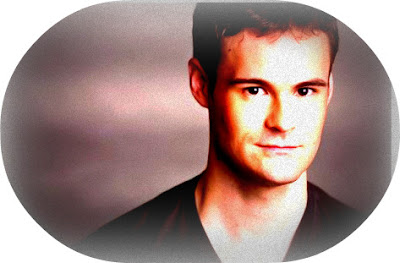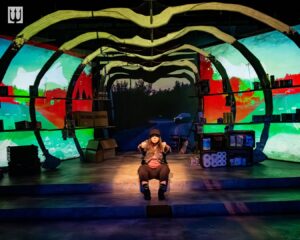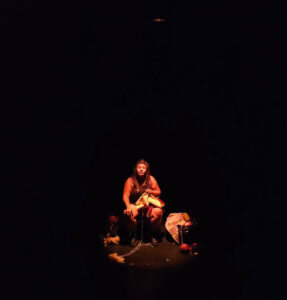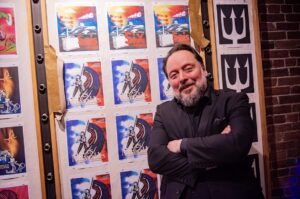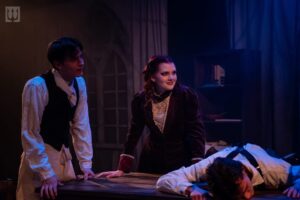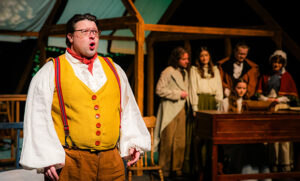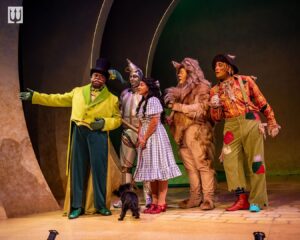It is a partly cloudy Wednesday in Halifax, Nova Scotia and after an epic trip to the grocery store, I sit on the couch in Haligonian actor Rhys Bevan-John’s living room surrounded by three adorable cats, one of which is poised on top of a gigantic fish tank. Bevan-John and I have known one another since he taught me the foundations of acting at Neptune Theatre School in 1997-98 and I, as a tree, threw apples at him, as a Scarecrow, in Elsinore Theatre’s production of The Wizard of Oz in 1999. His most recent venture is the founding of the Chaotic Good Physical Theatre Laboratory which uses the teachings of Tony Montanaro to explore the human body and how it can be used as a communicative vessel which can be adapted for theatrical means. A group of those interested in learning about (and practicing) physical theatre meet every Monday 7:00pm-9:30pm at either The Theatre Nova Scotia Space on Agricola Street or at the BusStop Theatre for their weekly workshop. This workshop is open to anyone on a drop-in basis! Bevan-John and I sat down and chatted about how Chaotic Good came about.
Amanda Campbell (AC): So, I’ll ask you the same question I ask people in Toronto. Who are you, where are you from and how did you get so talented?
Rhys Bevan-John (RBJ): Um, my name is Rhys Bevan-John, I’m from Dartmouth (Nova Scotia) and *sighs heartily and thinks about his answer* and I started as the loud kid in school. So, my mom put me in Neptune Theatre School classes. You know how kids have their ‘thing’? Like some kids are into soccer… I just always did theatre. I guess that’s how I’m talented. I was the loud kid in class.
AC: Do you remember what your favourite theatre games were as a kid?
RBJ: I remember really, really enjoying “This is a What,” like when I had gotten really, really good, it was really satisfying. … I really liked “Monarch”… I think like Kings and Queens. I’m trying to remember… you know, I don’t remember what my favourite ones were. I like doing shows the most, working with a script more than the gamey type stuff. When I was at the theatre school it wasn’t that far to get to Acting Youth IV, I think I did Acting Youth I, II and III in about a year and a half. And then in Youth IV we did The Terrible Fate of Humpty Dumpty. Gay Hauser directed. Gay Hauser was our teacher.
AC: I know that Tony Montanaro was a world famous mime, can you talk a little bit more about him and how you came to stay and study with him in Maine?
RBJ: Mime was really central to Tony’s life, he had me come live- part of the reason… he had lots of apprentices who came to live and learn around him, I just happened to be the last one *laughs*, but Tony told me once that the reason that he had me come down was obviously to teach me, he wanted to make me understand the things he was saying, but it was also for him. Through working with me, he was getting a better understanding of these processes through the teaching. Which, of course, is true of anything. He, uh, I think he had seven kids… two of which he found at a bus station. Two little Korean kids. The rest he had with his first wife Pam. And he spent a lot of time in different philosophical outlooks. He went to an ashram to study the Indian mediation form and lived there, and he synthesized everything into mime. And he was a Jersey boy. He was Italian American, his mom came over to America and he was born in New Jersey, and my mom is from Jersey too… although my grandmother was Hungarian, not Italian, still it was always nice for me to hear stories of his childhood. I kind of had sentimental feelings to his nostalgic remembrances of his childhood. And when would that have been? He was in his seventies… so it would have been in the late (19)30s.
AC: How did you first come across Tony?
RBJ: Jest in Time (Theatre), they brought Tony and Karen, his wife, in for a three day workshop and a performance. I was rehearsing for a dinner theatre show at the time at Halifax Feast. I had heard about (Jest in Time Theatre) as a kid because Christian Murray had worked with YPCo (Neptune’s Youth Performance Company) and my mother- well our next door neighbor- was friends with Christian… like he taught me how to juggle when I was a kid… So I knew Jest in Time and I knew of Tony that way. And I was really interested in physical theatre. And I remember it was one night at the Improv Knights, Gord Gammie said that, like, his girlfriend at the time had registered for this workshop, which was full up, but she had to cancel, but she hadn’t called to do it yet. And I had really wanted to do the workshop, except it was full. So I called Theatre Nova Scotia, or Jest in Time, whoever it was at the time, and I said “I know this girl is cancelling and I want her spot.” And I ended up calling before she did, and when she called she was like “Rhys Bevan John wants my spot.” And Tony and I really got along. I mean, I say we got along, here’s a man in his late sixties, and I was nineteen. I think that he appreciated my exuberance and thought that I would take well to what he did. So, he invited me to Maine for a three week advanced workshop, and usually these students who did this workshop were older and more advanced, but he had given me the green light. And that was really exciting for a nineteen year old. And so I went down there and spent my time with all these neo-Vaudevillians. There was this professional American storyteller, who made her living telling stories on the American storytelling circuit. And Takeo (Fujikura), the man who translated Tony’s book into Japanese, he has his doctorate in theatre and he’s a professor, but he’s also a professional mime. These were all people who made their livings being neo-style Vaudevillian performers. I was down there for three weeks and then Tony invited me to stay with him for six months and that’s when I lived with him at his home. The three week workshop had been at the barn, it used to be an old horse barn, and then it became home to a theatre company that toured internationally called The Celebrated Barn Theatre. Look, *gestures to his shirt* I’m wearing the t-shirt! When I lived with him at his home, he had a studio with a living dorm style living accommodations.
AC: When was this?
RBJ: That was in 2002.
AC: Right, so you’ve been home for quite awhile. What made you decide that now this was the time for you to start your own physical theatre workshop? Why is the Chaotic Good Physical Theatre Laboratory emerging now?
RBJ: Um, once I was down there I coerced a number of my friends to come down and stay with me too. My friend Mike McPhee lived there for four months and worked with Tony and he put it best when he said, “I feel like there’s work I should be doing that we’re not doing.” All I know is that before I started doing Chaotic Good Laboratory I was fundamentally unhappy, I was sad. Something was telling me that I need to do this work, and it’s not really something that you can do by yourself. I mean, you can do it in the corner of your living room, but that’s hard. I needed to start something to make it accessible to myself. And then I got a hold of some (theatre) spaces and now I’m happy. I dunno what it is that I’m doing or to what point it is that I’m going to take it; all I know is I just know that it satisfies me inside to be doing this work and it’s fun and exciting. And it took me awhile to reach this point. I looked around and I was thinking about going to school. I Assistant Directed a number of Sarah Stanley’s plays because I thought I wanted to be a director and I had a mind to maybe apply to the National Theatre School of Canada. After we worked together I asked the inevitable, “So I’m thinking of applying, what kind of fit do you think I am?” And she said “actually, I don’t think you are fit. I don’t think that you want to be a director, I think you want to be an actor and an acting teaching.” And she had such insight and was so astute, I am really grateful to her for that, because she was right. I didn’t have the vision to necessarily direct, I wanted to create things in ensembles. Then I was looking into York (University) because I have a friend who just finished the program there and there is someone who teaches a “Teach Physical Theatre Workshop” and she was underwhelmed with my experience, and not at all impressed that I had studied with Tony Montanaro for six months. And her name was Erika Batdorf, and she told me that I shouldn’t take the York MA, that I should just do physical theatre, and get people together and to just do it. She mentioned that having a group where you can get people to go away and learn things and then come back and share was really important. She said that I needed to engineer my life so that I was doing physical theatre as much as I could do it. Because she said that that is what she had done. She didn’t have a degree or anything. She had just done it. I am always finding myself considering going to school, but there is always something that holds me back. And I don’t know, I mean… I am impressed with, well, I’m impressed with you, Amanda, because you know so much about what is going on in theatre in Canada, and theatre in the world. And I find it hard enough keeping up with what’s going on in the theatre in Halifax! And that’s when I got sad. This work was missing in my life. When I wasn’t doing it, I was sad. Now that I am doing it, I am happy. I just don’t necessarily know the direction or the output of it yet.
AC: Where did the name Chaotic Good come from?
RBJ: Do you know the answer to this?
AC: Nooo….
RBJ: … Well- well, actually- basically the answer is Andrea Lee Norwood, she came up with it. But beyond that, it is a pop culture reference that some people will get and enjoy and the people who don’t get it will still get the sense of it. And I enjoy the sense either way… if someone gets my quirky, obscure reference than….
AC: Can you talk a bit about what the workshop is like?
RBJ: Yep! Um, over the past couple of months, few months, we have worked out what the beginning of each class is going to look like. At first we are silent for about five minutes, and then we do “Physical Choreography” for five minutes, then five minutes of “Spiritual Choreography”, than about five minutes of “Spiritual Choreography with the Oblique”, but sometimes we do less than five minutes of that because it gets really tiring. Then we do “Verbal Choreography” and we do this all en masse so that no one is watching anyone. Then we do rolls across the floor in various styles. All of these are Montanaro style. We have different ideas of shapes that will carry you across the floor. And then we do Open Rounds. So depending on if everyone there has been to the Lab before, or if there are new people and I have to talk everyone through it, this can take 45 minutes. It’s a very personal time, the first 45 minutes. And then after that it really becomes more of a laboratory. People will ask if we can do certain favourite exercises to explore things. It also depends on how many people are there too. Sometimes people say, “let’s try this!” and it’s interesting, and then we say “okay, let’s try this again, but do this part differently.” This Monday Courtney Siebring is going to do some exercises that she learned at her Comedia Dell’Arte school. And that’s going to be great! Because I dunno what it is she is running, but I know that she has a wealth of knowledge that I don’t have. That’s like this morning, with Gina Thornhill, she has been working with Double Edge Theatre in Massachusetts for the past four months and so she was giving us a taste of what she had been doing down there. Generally Montanaro style exercises lend themselves to an open-ended laboratory atmosphere. We say, “let’s try this out”, “let’s see what this is.” There’s one thing that I’m a little bit upset with myself with, because I haven’t been focused on physical technique. We’ve been doing a lot of the froufrou elements of the work which is akin to excavating the geology and the layers of your ego. This doesn’t necessarily sculpt bodies in any particular way and I think that technique is important to shaping bodies. I have been remiss in not adding that. We have been doing things that would appear abstract as opposed to technical.
AC: When I went to your Open Class Presentation I noticed that for almost every sketch, there was one person who seemed to be acting as the “outside eye” or even the director of the work—
RBJ: Yeah, I wanted for that to give everyone an opportunity, who wanted to, to take the director’s role. There’s one thing that I felt really bad about that night, the Evolution sketch that you said you liked so much, Mike McPhee directed that. I meant to say it on the night because Mike does this work really, really well. I wanted to give everyone the chance to be that outside eye, if they had a vision they wanted to realize because I didn’t want it to just be a workshop where I stood up all the time and was like “Okay, guys, I’m going to do lots of stuff!”
RBJ: Yeah, I wanted for that to give everyone an opportunity, who wanted to, to take the director’s role. There’s one thing that I felt really bad about that night, the Evolution sketch that you said you liked so much, Mike McPhee directed that. I meant to say it on the night because Mike does this work really, really well. I wanted to give everyone the chance to be that outside eye, if they had a vision they wanted to realize because I didn’t want it to just be a workshop where I stood up all the time and was like “Okay, guys, I’m going to do lots of stuff!”
AC: I also noticed that the work that was presented in the Open Class was very sketch based, like physical sketches as opposed to verbal ones. You met with great success in 2004 with your sketch comedy troupe The HenMen where you, Chris Kelly, Colin Cowan and Bill Wood did shows in Halifax, at the Edinburgh Fringe Festival and other venues in Europe, so I was wondering if you see yourself creating this different type of sketch show and presenting it to an audience in the future?
RBJ: When I was studying with Tony one of his fundamental things was communicating using the body. And I learned that even if I wrote down verbatim everything he said, and I often took notes, it didn’t communicate the underline explosion of what he was saying. It was more about the emphasis than the words that he was saying. He could communicate so much just with emphasis. He said to me once *speaks very meticulously and slowly* “when you’re onstage you really have to listen to the other person onstage.” Which doesn’t translate to the page, it’s not just that he’s speaking in italics, but utter explosion. You have to turn on everything and make your body a vessel to the other person. What was your question? Oh yeah, well– the answer is, maybe. I don’t know what we’re planning. I would like to work on something, but we all have different ideas on how it should manifest itself into a Chaotic Good Show. I would like to get Evan Brown to write something, and it looks like we would get Jennette White to direct, but each of the three of us have different ideas on who we would like to have involved. I would like to have it open to all the members of the lab who would like to participate. We haven’t really talked about it a lot yet. But it’s a good idea. The style (of sketch) really lends itself to this type of theatre. We could create a physical sketch show and tour it around and make money, maybe we could even take it to schools. That would be a fun, physical sketchy thing. Maybe. I could be talked into it.
AC: You’ve also done a lot of “mainstream” theatre including productions of Oliver and The Miracle Worker at Neptune Theatre. Do you find that you can adapt your physical theatre training to suit the needs of these shows? Or do you have to approach them differently?
RBJ: All the work I’ve done with Tony completely supports the more “conventional” work that I’ve done. Especially film. I had no idea how to work in film until I worked with Tony because it’s a lot about subtext. If you watch people that you enjoy in films, people that you get engrossed in- if you were able to notice what was happening to you as you watch them, I think that it would be like there was an inner typewriter going on in their body and then there is an inner typewriter going on in your body and you are reading people’s facial expressions to sort out what is actually going on. It’s like I was saying at the Open Class, as children we are completely transparent, and we walk around showing exactly how we are feeling and what we are thinking and what we want. We learn to become less transparent as we get older so that people can’t eff with us. So Tony was teaching us to become more transparent, because that’s what mime and physical theatre is. One element of doing that is developing your perceptic senses, the body’s sixth sense, which is the body’s ability to sense itself. It is habitual and not conscious. If you don’t have awareness in a certain part of your body than you can’t invest part of yourself in that body part and so it becomes more opaque for the conduit of your “humanity.” It’s like a batter swinging five bats, once you’ve done it a whole lot and had a lot of practice you can start to use it to a small degree. The most profound example I had of this was working on a film called Crossing Over which was a wonderful experience. The script had no lines, it was all silent. Because it was a Film 5 project the journey of the character was only suggested, but nothing was actually given to me as an actor. It was all in the directions of “shoot him doing this or that.” I wrote a second script that had all my inner dialogue in it, and the first time I did all the facial expressions ten out of ten- really big. Like, *says with hugely animated face* “What’s that over there!?” and that’s when my film acting really started to make sense to me. I kept doing it at 10 with my imaginary body but I didn’t do anything with my actual body so all my reactions were really supported, and my intentions were strong and yet there was very little on my face. And there was this great moment when the First AD asked the Director which lens he wanted to use, and Cam (the director) was like, “Get the, like, A353 or whatever, lens, I think we need to get in close because it’s so subtle what he’s doing.” And I had this moment of like looking up at the sky and screaming, “DID YOU HEAR THAT WORLD? SUBTLE! ME!” *laughs* Because usually I’m so exuberant. It was really gratifying at the time. It’s the same thing for theatre. It’s all- the goal of the work is to learn to use the body as a communicative tool. And that’s what you’re doing up onstage.
AC: What was one of the most impressive pieces of theatre that you have seen recently?
RBJ: Can I say a number of them?
AC: Sure!
RBJ: Ubuntu was really good, I don’t know what to say about it. Did you see it?
AC: Yeah, I did, in Toronto.
RBJ: Yeah, of course you saw it. Yeah. It was just impressive. So impressive. But also Homage, 2b theatre’s last show, that was impressive all around. It was impressive dramaturgically, and of course the set… the set was impressive… and the acting was impressive and the writing… I dunno what to say. It was really impressive. And then there was Grandma Noda’s Tigers which Chris Little did at the BusStop. I wept. It was the most satisfying thing that I’ve seen in a long time. It was so simple, honest, genuine, and it really sucked me in and like I said, it made me weep. It was beautiful.
AC: Halifax audiences really love watching you, and I know you and I have talked about your future ideas and plans, but I wondered if there was anything that you have in the works as an actor that you can disclose to the public?
RBJ: I plan to do a one man story telling of The Happy Prince by Oscar Wilde and it’s 99% sure going to be directed by Jennette White.
AC: So, if there are people reading this who are interested in Physical Theatre, but maybe feel like they don’t have enough experience, or they’re slow to commit to coming out and trying something that is unknown to them, what would you say? Why should Haligonians come to Chaotic Good Physical Theatre Laboratory instead of staying home and playing Mario Kart?
RBJ: To quote- no, better make that, to paraphrase Lorna Marshall’s The Body Speaks “the goal of this work is not to be interesting but to be interested in the experience that you have.” I spent a lot of time not being aware of my mind or body and this work forces you to be really present, which is very satisfying on a fundamentally human level. And it’s a lot of fun! And you feel really good after you’ve done it. The hardest part is just getting there. When my friend Bill Wood and I were living in one room in England while doing The HenMen we would feel terrible and miserable at the thought of getting up and doing this physical work. We wouldn’t want to do it. But then every time, afterward, it would brighten us. I will say this, there have been many occasions where if I wasn’t the guy with the keys, I wouldn’t have gone to Lab, just because I was too tired or wasn’t in the mood or whatnot. But I have never gone in feeling like that and not come out feeling great. Secondly, I know for myself, when I was younger, the reason that I did things like drinking, was because I felt this energy and it had no release. There was all this physical tension inside of me with no socially acceptable release. This work gives you that release, it is a valve for the release of that steam, and that is so satisfying and gratifying to do.
You can join “Chaotic Good Physical Theatre Laboratory” on Facebook for more information and everyone is highly encouraged to show up Monday Nights at 7:00pm (email rhysbevanjohn@gmail.com to double check if the meeting is at the Space or the BusStop). The drop-in fee is a remarkable $5.00 and you’re guaranteed to have a unique, challenging, and utterly fulfilling experience!

